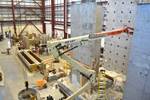Prismatic tiles by Planefibra improve natural light
Glass fiber-reinforced polymer tiles for civil structure applications increase lighting efficiency by 30%, are more cost-efficient than polycarbonate tiles.
Planefibra (Santa Catarina, Brazil), in addition to translucent and opaque composite roof tiles, has incorporated prisms into its translucent glass fiber-reinforced polymer (GFRP) tiles, developing a product solution that increases the use of natural light by around 30% — this is said to be on par with the efficiency of prismatic polycarbonate tiles.
“In addition to greater diffusion of sunlight, prismatic GFRP tiles guarantee more visual comfort, as they avoid the hot spot effect, an unwanted phenomenon in which an excessively bright point of light is formed and concentrated in a certain area,” Valério Heuchling, commercial manager at Planefibra, explains.
Called Extralux, Planefibra’s new product is distinctive in its high mechanical and chemical resistance — GFRP is used, for example, in space shuttle components and F1 cockpits. Therefore, even in places where the incidence of sunlight is high, there is no risk of deformation. Another advantage is the production of custom-made tiles, which adapt to the various existing roof models.
Planefibra also includes ultraviolet protection films on both sides of the tile. “Our prismatic tiles are manufactured following NBR 16753 standard, have a minimum useful life of 10 years and can offer adequate resistance to spreading flames,” Heuchling adds.
Moreover, the prismatic GFRP tiles cost around 40% less than polycarbonate tile counterparts. “We understand that our entry into the prismatic segment will be beneficial not only for Planefibra but for the Brazilian GFRP market as a whole, as the material tends to be even more valued in this and other applications in the construction industry,” Heuchling concludes.
Related Content
-
Sulapac introduces Sulapac Flow 1.7 to replace PLA, ABS and PP in FDM, FGF
Available as filament and granules for extrusion, new wood composite matches properties yet is compostable, eliminates microplastics and reduces carbon footprint.
-
TU Munich develops cuboidal conformable tanks using carbon fiber composites for increased hydrogen storage
Flat tank enabling standard platform for BEV and FCEV uses thermoplastic and thermoset composites, overwrapped skeleton design in pursuit of 25% more H2 storage.
-
The lessons behind OceanGate
Carbon fiber composites faced much criticism in the wake of the OceanGate submersible accident. CW’s publisher Jeff Sloan explains that it’s not that simple.
















